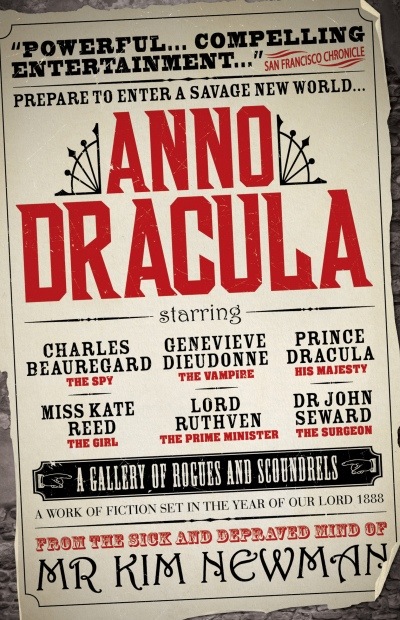I have a confession.
I love Dracula. Both the character and Stoker’s novel.
And I love vampires.
Not the sparkly, fairy, effete version populating Meyer’s asinine attempts at fiction (“Dear Dracula, do you remember that one night seventeen years ago? Well, we need to talk. Sincerely, Tinkerbell”) but full blown raging bloodlust sensual sexual visceral vampires. Buffy’s Angel and werewolves may be a tortured soul trapped in a bestial form struggling to contain their animal appetites (which has its own appeal) but a real true dyed-in-the-wool vampire revels in and relishes their evil.
The concept for this book, then, had an automatic appeal: Dracula had arrived in England; he seduced and turned Lucy Westenra who is dispatched by the forces of light comprising Arthur Holmwood, John Seward and Quincey Morris. As the forces of light attempt to track down Dracula, he turns his attention to Mina Harker. At this point, Newman’s narrative departs from Stoker’s: Dracula kills Jonathan Harker and Quincey Morris; he seduces Queen Victoria and becomes Prince Consort; a world of vampires flocks to England to make a stab at (or to take a bite at) an openly vampiric life.
History and fiction mingle in Newman’s tale: Stoker and Van Helsing are both characters; Inspectors Lestrade and Abberline work side by side; Sherlock Holmes has been incarcerated in a ‘warm’ concentration camp; doctors Moreau and Jekyll investigate vampire physiology. Vampires from fiction abound from Lord Rothven (appropriately for the first literary vampire in Polidori’s The Vampyre now Prime Minister to less familiar names such as Kostaki, von Klatka and Count Vardalek.
As a self confessed geek, there is an undeniable delight in recognising the various recreations and re-imaginings of famous and less famous characters.
Had that been the only pleasure, though, this would have been a thin, poor novel. Fortunately, it is not the only pleasure: Newman’s story remains rooted in the final years of the nineteenth century and focusses on the Jack the Ripper murders. The Ripper’s victims, Nichols, Chapman, Stride, Eddowes and Kelly remain prostitutes in Whitechapel but are now vampire prostitutes and their murders attract the attention of Scotland Yard; Queen Victoria herself; the shadowy Diogenes Club headed by Mycroft Holmes (which exists somewhere between diplomacy and warfare on behalf of the Queen); the criminal spider’s web headed by Fu Manchu, the Lord of Strange Deaths, and Professor Moriarty; and the philanthropic hospital and charity of Toynbee Hall.
Our main characters are Geneviève Dieudonné and Charles Beauregard. Geneviève is a four hundred year old Vampire elder who works as assistant director of the Hall under Dracula‘s Jack Seward; Charles is an agent of the Diogenes Club and, through them, the Queen. Geneviève in particular is a quite compelling character: turned at the age of sixteen and remaining in a sixteen year old body, she remains a strong moral anchor in the world. Enough of her history and powers are hinted at that she comes across as indomitable throughout the novel even though we never truly see her unleash that power. Charles Beauregard by contrast is a lesser character: mired in duty and obligation to his Queen, his fiancée and his deceased wife he is so much less confident and compelling than Geneviève.
The novel conjures up all the expected cliches of Victorian London with Hanson cabs, fogs and gas lamps yet manages to remain fresh and convincing. The addition of the vampires into the social sink of Whitechapel, where a threepenny could buy you both a roll in the hay and a blood letting, deepens the griminess of the area. One woman in a particularly unpleasant image trails the streets of Whitechapel with two children in tow (which may or may not be her own) to pimp their blood to passing vampires.
The vampires themselves are not quite the full blooded bloodsuckers I had hoped for. The magic and superstition of Dracula is stripped away, as is their antipathy to crosses and holy water and garlic. These vampires are more natural than Stoker’s: they’re still preternaturally strong, heal almost instantly from most injuries, have a various abilities depending on their bloodlines including almost psychic sensitivity to others’ thoughts or shapeshifting; sunlight can burn newly turned vampires and silver can prevent wounds from closing. It is from this silver that Jack the Ripper is dubbed Silverknife before the Ripper moniker is attached to him.
There is a wider larger plot behind the efforts to track down the Ripper but in fear of spoilers I shall not dwell on that. It did manage to take me by surprise in the final hour of the audiobook!



Its weird. I just blogged about Twilight and Dracula earlier, nice post. Mine is at http://philipdeane.wordpress.com/2012/04/25/would-twilight-make-bram-stoker-spin-in-his-grave/
LikeLike
Sounds intriguing. I, too, have blogged about Dracula and Twilight… I am so much opposed to the vampire as love interest. Sparkly? Please…
LikeLike
It is a bit of a geek book! The depiction of Dracula in the final chapter is most definitely not sparkly! Corpulent and bestial and malevolent yet still somehow dangerously seductive. A fun read!
I’ve not read a vampire tale that can hold a light to Stoker!
LikeLike
[…] Kim Newman, Anno Dracula […]
LikeLike
[…] Anno Dracula, Kim Newman […]
LikeLike